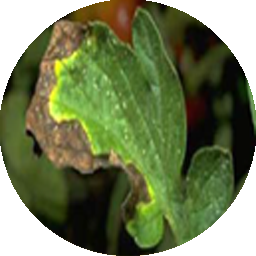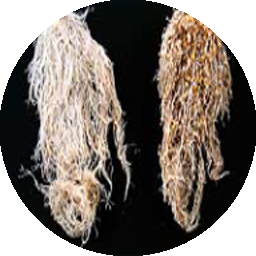Tomato Symptoms & Management
×
Symptoms:
1. Symptoms vary among hosts and in a single host species
2. Stunting is a common symptom of TSWV infection
3. Chlorotic or necrotic rings form on the leaves of many infected hosts.
4. Thickening of veins and bronzing of young leaves
5. Growing tips may die-back and terminal branches may be streaked
6. Affected plants may have a one sided growth habit or may be entirely stunted and have drooping leaves, suggesting a wilt
7. Pale red or yellow areas with concentric circular marking in the normal red skin of ripe tomato are formed
8. Discoloration of seed
Management:
1.Removal and destruction of infected plants & weed hosts
2.Growing Crotolaria juncea as a barrier crop reduces vector migration
3.Vector control with dimethoate or methyl demeton at 10 days interval. Fepronil 1.5 ml/l is specific to thrips management
×
Symptoms:
1.Disease appears as spots on leaves, stems and fruits and as wilting of leaves and shoots
2.White blister like spots in the margins of leaves
3.Spots become brown with age and coalesce, but leaves do not fall off
4.Leaflets on one side of rachis show withering initially.
5.Light coloured streaks on stems and petioles at the joints
6.Cracks develop in streaks and form cankers
7. Slimy bacterial ooze through the cracks in humid weather
8.Small, shallow, water soaked, spots with white halo develop on fruits
9.The centers of spots become slightly raised, tan coloured and rough
10.Vascular discolouration is seen in split open stems
Management:
1. Extraction of seed through fermentation of pulp at room temperature for 72 hours eradicates the bacterium from the seed. Anaerobic conditions in fermentation leads to production of several organic acids which will inactivate he bacterium resulting in extraction of healthy seed
2. Hot water treatment of seed at 520 C
3. Three year crop rotation
4. Protective sprays with COC 3000 ppm + streptomycin sulphate 100 ppm
×
Symptoms:
1.Indistinct external symptoms
2.Infected plants in patches in the field
3.Formation of galls on host root system is the primary symptom
4.Roots branch profusely starting from the gall tissue causing a ‘beard root’ symptom
5.Infected roots become knobby and knotty
6.In severely infected plants the root system is reduced and the rootlets are almost completely absent. The roots are seriously hampered in their function of uptake and transport of water and nutrients
7.Plants wilt during the hot part of day, especially under dry conditions and are often stunted
8.Seedlings infected in nursery do not normally survive transplanting and those surviving have reduced flowering and fruit production
9.Nematode infection predisposes plants to fungal and bacterial root pathogens
Management:
1. Crop rotation with graminaceous crops
2. Inclusion of non-preferred hosts like mustard, sesame, maize, wheat, etc., in the cropping system
3. Intercropping of marigold with tomato reduces nematode population
4. Nursery should be raised in nematode free sites or fumigated or solarized beds
5. Deep ploughing of infested fields during summer. Three summer ploughings at 10 days interval reduces juvenile population
6. Flooding the field for prolonged periods
7. Use of biocontrol agents like Paecilomyces lilacinus (egg parasite)
8. Nursery bed treatment with metham sodium (Vapam) @ 25ml/m2 or Carbofuran @ 0.39g a.i/m2
9. Bare root dip treatment in EC formulation of systemic insecticides like Dimethoate or Phenemiphos for 6-8 hours before transplantation
10. Grow resistant varieties like Hissar Lalit, PNR-7, Nematex, NTDR 1 and VFN 8
11. Spot application of carbofuran @1 kg a.i/ha at transplanting stage in the main field



